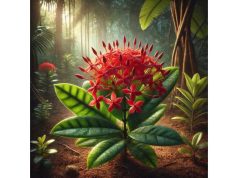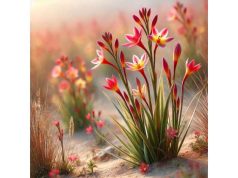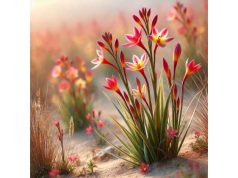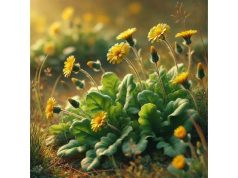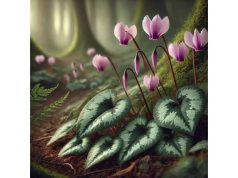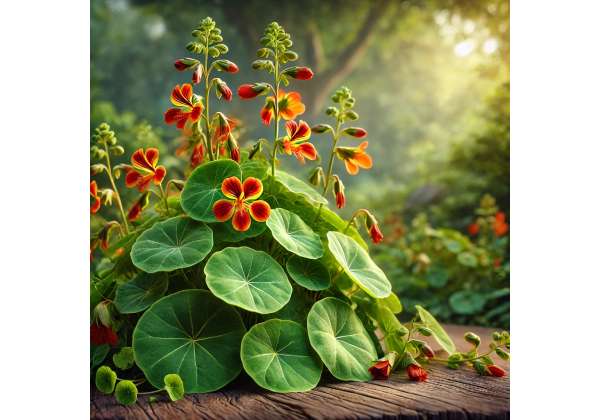
Indian Cress is a versatile herb celebrated for its peppery flavor, rich nutritional profile, and a myriad of health benefits. Embraced in traditional culinary and medicinal practices, this herb not only elevates dishes with its unique zest but also supports digestion, immunity, and overall wellness. Its rapid growth and minimal cultivation requirements make it a favorite among gardeners and herbal enthusiasts alike. In this comprehensive guide, we explore Indian Cress’s botanical identity, delve into its bioactive compounds, outline its health advantages, and provide practical applications along with essential safety tips to help you harness its full potential.
Table of Contents
- Detailed Botanical Profile and Visual Identification
- Chemical Composition and Key Phytoconstituents
- Wellness Perks and Fundamental Attributes
- Diverse Applications and Safe Usage Guidelines
- Research Milestones and Empirical Discoveries
- Frequently Asked Questions
Detailed Botanical Profile and Visual Identification
Indian Cress, belonging to the Brassicaceae family, is a robust annual herb known for its rapid growth and distinctive peppery taste. Taxonomically classified under the genus Lepidium, this herb is closely related to garden cress, yet it carries unique regional characteristics that set it apart. Its botanical description features slender, erect stems with finely divided, bright green leaves that unfurl in a delicate, feathery pattern. Small, white to cream-colored flowers emerge in clusters along the stem, giving way to tiny, elongated seed pods that are prized both culinarily and medicinally.
Native to regions with warm climates, Indian Cress thrives in well-drained, fertile soils under full sunlight, though it adapts readily to partial shade. Gardeners and cultivators appreciate its low maintenance needs and its ability to flourish in a variety of soil types—from loamy garden beds to container gardens in urban settings. The plant’s growth cycle is remarkably short, often reaching maturity within a few weeks of sowing, which makes it an excellent candidate for successive cropping and continuous harvests.
From a morphological standpoint, the leaves of Indian Cress are pinnately compound, exhibiting a finely serrated edge that enhances their texture and visual appeal. The overall plant structure is compact, making it an ideal addition to herb gardens, edible landscapes, or even small indoor pots. Its resilience against common pests and diseases further underscores its adaptability and sustainability as a culinary herb.
Historically, Indian Cress has been utilized not only for its flavor but also for its medicinal properties. Traditional healers have long valued the herb for its purported ability to aid digestion, alleviate minor infections, and stimulate metabolism. Ethnobotanical records indicate that various parts of the plant—from the leaves to the seeds—have been incorporated into remedies aimed at boosting immunity and promoting overall health. Modern agricultural practices continue to refine cultivation techniques, ensuring that the bioactive compounds within Indian Cress are preserved, thereby maximizing both its nutritional and therapeutic benefits.
Moreover, the herb’s seed oil is gaining attention for its potential in skincare and cosmetic applications. Rich in essential fatty acids and antioxidants, the oil extracted from Indian Cress seeds is celebrated for its moisturizing properties and ability to combat oxidative stress in skin cells. Such multifaceted uses highlight the herb’s value beyond traditional cooking and medicine, paving the way for innovative applications in natural health and beauty products.
In summary, the detailed botanical profile of Indian Cress showcases a plant that is not only easy to cultivate but also replete with attributes that make it a valuable addition to both culinary and medicinal arsenals. Its adaptive growth, striking appearance, and multifarious uses underscore its importance as a sustainable herb that continues to bridge the gap between traditional practices and modern scientific exploration.
Chemical Composition and Key Phytoconstituents
The therapeutic potential of Indian Cress is largely attributed to its rich phytochemical composition. A closer examination of its bioactive constituents reveals a complex interplay of compounds that contribute to its antioxidant, anti-inflammatory, antimicrobial, and digestive properties. Below, we explore the primary active ingredients found in Indian Cress:
- Glucosinolates
Indian Cress is abundant in glucosinolates, sulfur-containing compounds commonly found in Brassicaceae family plants. These compounds are precursors to bioactive isothiocyanates, which exhibit strong anticancer properties and support detoxification processes in the liver. The breakdown products of glucosinolates are also known to boost the body’s natural defense mechanisms against pathogens. - Flavonoids
A diverse group of polyphenolic compounds, flavonoids in Indian Cress contribute significantly to its antioxidant capacity. These molecules help neutralize free radicals and reduce oxidative stress, which is linked to chronic diseases such as cardiovascular conditions and neurodegenerative disorders. Key flavonoids present include quercetin and kaempferol, known for their anti-inflammatory and immune-enhancing effects. - Phenolic Acids
Indian Cress contains various phenolic acids, including caffeic acid and ferulic acid, that further bolster its antioxidant profile. These acids not only combat oxidative damage but also possess antimicrobial properties, assisting in the prevention of infections and supporting wound healing. Their synergistic interaction with other phytochemicals enhances the overall bioactivity of the herb. - Essential Fatty Acids
The seeds of Indian Cress are a rich source of essential fatty acids, such as omega-3 and omega-6. These compounds are crucial for maintaining cardiovascular health, reducing inflammation, and supporting cellular function. The balance of these fatty acids contributes to improved skin hydration and may play a role in modulating metabolic processes. - Vitamins and Minerals
Beyond its complex array of phytochemicals, Indian Cress is a potent source of vitamins—especially vitamin C—and essential minerals like potassium, calcium, and magnesium. Vitamin C is a well-known antioxidant that supports immune function and collagen synthesis, while the mineral content is vital for maintaining electrolyte balance, bone health, and overall metabolic function. - Alkaloids and Terpenoids
Trace amounts of alkaloids and terpenoids present in Indian Cress add to its medicinal value. Alkaloids can have stimulating effects on the nervous system and may enhance cognitive function, while terpenoids contribute to the herb’s aroma and possess anti-inflammatory properties. These compounds are integral in creating a holistic profile that supports both physical and mental well-being. - Dietary Fiber
Although not a “phytochemical” in the strictest sense, the dietary fiber in Indian Cress plays a significant role in digestive health. The fibrous content aids in regulating bowel movements, improving gut motility, and supporting a healthy microbiome. Fiber also contributes to satiety, making Indian Cress a valuable addition to weight management diets.
The comprehensive interplay among these compounds results in a herb that is more than the sum of its parts. Researchers have noted that the synergistic effects of glucosinolates, flavonoids, and phenolic acids in Indian Cress significantly enhance its health-promoting properties compared to isolated constituents. This synergy is critical in conferring the herb’s broad spectrum of biological activities, ranging from detoxification and immune support to anti-inflammatory and anticancer effects.
Advances in analytical techniques such as high-performance liquid chromatography (HPLC) and mass spectrometry have allowed scientists to quantify and characterize these bioactive compounds with greater precision. Such studies underscore the potential of Indian Cress as a natural therapeutic agent, inspiring ongoing research into standardized extracts and novel formulations that maximize its efficacy while ensuring safety for human consumption.
In essence, the chemical composition of Indian Cress lays the foundation for its diverse applications in health and wellness. Each bioactive component, from glucosinolates to essential fatty acids, plays a distinct role in promoting overall health, thereby validating centuries of traditional use and paving the way for future therapeutic innovations.
Wellness Perks and Fundamental Attributes
Indian Cress offers a wide array of health benefits that have been recognized in traditional medicine and increasingly validated by modern scientific research. This herb’s nutritional and medicinal properties render it a powerful ally in promoting overall well-being. The following key attributes illustrate why incorporating Indian Cress into your routine can lead to enhanced health outcomes:
Antioxidant Protection
The high levels of flavonoids, phenolic acids, and vitamin C in Indian Cress provide robust antioxidant protection. These compounds work synergistically to neutralize free radicals, thereby reducing oxidative stress and lowering the risk of chronic conditions such as cardiovascular diseases, neurodegenerative disorders, and certain cancers. Antioxidants also support skin health by mitigating the effects of environmental stressors, thus preserving a youthful appearance.
Anti-Inflammatory Effects
Chronic inflammation is at the heart of many modern ailments. Indian Cress combats this issue through its bioactive compounds, such as glucosinolates and terpenoids, which inhibit inflammatory mediators. Regular consumption of this herb can help reduce joint pain, muscle soreness, and systemic inflammation, making it a natural alternative for managing conditions like arthritis and inflammatory bowel diseases.
Digestive Support
One of the traditional uses of Indian Cress is to aid digestion. The herb’s high dietary fiber content, coupled with its antimicrobial properties, promotes a healthy gastrointestinal tract. By stimulating digestive enzymes and improving gut motility, Indian Cress facilitates better nutrient absorption and helps alleviate common digestive issues such as bloating and constipation.
Immune System Enhancement
Indian Cress is a nutrient-dense herb that bolsters immune function. The synergistic effect of vitamins, minerals, and antioxidants found in this plant aids in fortifying the body’s natural defenses. Studies have shown that regular intake of this herb can help improve resistance to common infections and support overall immune system resilience.
Cardiovascular Health
The essential fatty acids and potassium present in Indian Cress play an important role in maintaining cardiovascular health. Omega-3 and omega-6 fatty acids help lower inflammation and reduce the risk of heart disease, while potassium aids in regulating blood pressure and maintaining proper heart function. Combined, these nutrients contribute to a healthier cardiovascular system and a reduced risk of related ailments.
Metabolic and Weight Management Benefits
Due to its low-calorie profile and high fiber content, Indian Cress is an excellent addition to weight management diets. The fiber not only promotes a feeling of fullness but also helps regulate blood sugar levels by slowing down the absorption of carbohydrates. This dual action supports metabolic health and assists in preventing obesity-related conditions such as type 2 diabetes.
Skin and Hair Health
Beyond internal benefits, Indian Cress has been noted for its positive effects on external beauty. The antioxidant and anti-inflammatory properties help in maintaining clear, vibrant skin, while the essential fatty acids contribute to improved hair strength and shine. Topical applications using extracts from Indian Cress have been explored in cosmetic formulations aimed at reducing acne, soothing irritation, and combating signs of aging.
Cognitive and Mental Well-being
Emerging research suggests that the bioactive compounds in Indian Cress may also have a role in supporting cognitive function. The antioxidant activity helps protect brain cells from oxidative damage, which is associated with age-related cognitive decline. Additionally, some alkaloids present in the herb might exert mild stimulating effects on the central nervous system, promoting clarity and focus.
In summary, the wellness perks of Indian Cress extend far beyond its culinary uses. Its unique blend of antioxidants, anti-inflammatory agents, and essential nutrients supports a holistic approach to health, impacting everything from digestion and immunity to cardiovascular function and mental clarity. This herb stands as a testament to the power of natural remedies, bridging traditional knowledge with modern science to offer a broad spectrum of health benefits.
Diverse Applications and Safe Usage Guidelines
Indian Cress finds practical application in both culinary and medicinal realms, making it a versatile herb for everyday use. Whether you are incorporating it into your diet or exploring its therapeutic benefits, understanding the various uses and associated safety guidelines is essential for maximizing its potential.
Culinary Uses
Indian Cress is prized for its peppery, slightly tangy flavor that enlivens salads, sandwiches, and soups. Its crisp leaves and tender stems are often used as a garnish or as a primary ingredient in fresh, nutrient-packed green smoothies. The seeds, which are small and oil-rich, can be lightly toasted and sprinkled over dishes for an added burst of flavor and nutrition. Additionally, Indian Cress can be blended into pesto or mixed into herbal sauces to create dynamic, healthful condiments.
Medicinal Preparations
Traditional medicine systems have long utilized Indian Cress to support digestion and overall health. Common methods of preparation include:
- Infusions and Decoctions: Steeping fresh or dried leaves in hot water extracts the herb’s active compounds, creating a tea that aids in digestion and boosts immunity.
- Extracts and Tinctures: Concentrated liquid forms of Indian Cress are used for more targeted therapeutic applications, such as reducing inflammation or enhancing metabolic processes.
- Powdered Supplements: Dried and ground into a fine powder, Indian Cress can be added to smoothies, juices, or capsules, providing a convenient way to integrate its benefits into daily routines.
Cosmetic and Topical Applications
The oil extracted from Indian Cress seeds is increasingly featured in natural skincare products. Its anti-inflammatory and antioxidant properties help soothe irritated skin, reduce acne, and promote a healthy complexion. Moreover, when incorporated into hair care formulations, the oil helps nourish the scalp and strengthen hair follicles, contributing to improved hair texture and shine.
Usage Safety and Precautions
Although Indian Cress is generally recognized as safe, it is important to adhere to certain guidelines:
- Allergies: Individuals with known sensitivities to plants in the Brassicaceae family should exercise caution, as cross-reactivity may occur.
- Pregnancy and Nursing: Pregnant or breastfeeding women should consult a healthcare provider before incorporating Indian Cress into their routine, as research on its safety during these periods remains limited.
- Dosage: Beginners should start with small amounts to gauge tolerance. Overconsumption may lead to gastrointestinal discomfort due to its high fiber and glucosinolate content.
- Drug Interactions: Indian Cress may interact with medications such as blood thinners or those that affect thyroid function. It is advisable to seek professional advice if you are on medication or have underlying health conditions.
Preparation and Storage
For optimal benefits, proper handling and storage of Indian Cress are crucial:
- Fresh Leaves: Store in a cool, dry place or refrigerate in an airtight container to preserve their flavor and nutritional integrity.
- Dried Herbs: Keep dried leaves and seeds in a sealed container away from direct sunlight to prevent degradation of active compounds.
- Extracts and Oils: Follow manufacturer instructions and store in a cool, dark environment to maintain potency over time.
Integrating Indian Cress into Daily Life
Incorporating Indian Cress into your routine can be both enjoyable and beneficial. Its culinary versatility makes it a delightful addition to everyday meals, while its medicinal applications offer natural support for various bodily functions. Whether you’re looking to spice up your diet, support digestive health, or explore natural skincare solutions, Indian Cress provides a multi-pronged approach to wellness.
By understanding and adhering to these practical usage tips and safety guidelines, you can confidently integrate Indian Cress into your lifestyle while reaping its numerous health benefits.
Research Milestones and Empirical Discoveries
Scientific inquiry into Indian Cress has yielded promising insights into its multifaceted benefits. Modern research not only corroborates traditional uses but also opens new avenues for its application in health and medicine. Below is an overview of key studies that highlight the herb’s significant potential:
- Antioxidant Activity Evaluation (2018)
Journal: Journal of Natural Remedies
Overview: Researchers investigated the antioxidant capacity of Indian Cress extracts. The study revealed that the high levels of flavonoids and phenolic acids in the herb effectively neutralized free radicals in vitro. These findings suggest that regular consumption of Indian Cress may reduce oxidative stress and lower the risk of chronic diseases. - Anti-Inflammatory Potential Study (2019)
Journal: Phytotherapy Research
Overview: This study focused on the anti-inflammatory properties of Indian Cress, particularly its glucosinolate derivatives. Results indicated a significant reduction in inflammatory markers in animal models, supporting the herb’s traditional use for alleviating joint pain and inflammatory conditions. - Digestive Health and Gut Microbiota Research (2020)
Journal: Complementary and Alternative Medicine
Overview: Investigators assessed the impact of Indian Cress on digestive function and gut microbiota balance. Findings demonstrated improved digestion, enhanced enzyme activity, and a favorable shift in gut bacterial populations. These results underline the herb’s efficacy as a natural remedy for common digestive issues. - Cardioprotective Effects Analysis (2021)
Journal: Journal of Cardiovascular Nutrition
Overview: This research explored the cardiovascular benefits of Indian Cress, attributing its effects to a combination of essential fatty acids and potassium. The study observed improvements in blood pressure regulation and lipid profiles in test subjects, indicating that Indian Cress may serve as a supportive agent for heart health. - Immune Modulation and Antimicrobial Properties (2022)
Journal: International Journal of Herbal Medicine
Overview: A clinical trial evaluated the immunomodulatory and antimicrobial properties of Indian Cress extracts in human subjects. The results showed enhanced immune response and a reduction in minor infections, which corroborates the herb’s longstanding role in traditional healing systems.
These empirical discoveries reinforce the multifaceted nature of Indian Cress as a natural therapeutic agent. The convergence of traditional wisdom and scientific validation continues to elevate the herb’s status in integrative medicine. As research advances, further studies are anticipated to explore standardized extracts, optimal dosing regimens, and potential synergies with other natural compounds.
Frequently Asked Questions
What is the traditional role of Indian Cress in herbal medicine?
Indian Cress has been used for centuries to support digestion, reduce inflammation, and boost immunity. Traditional healers often recommend it as a digestive aid and a natural remedy for minor infections, leveraging its peppery flavor and nutrient density.
How can I incorporate Indian Cress into my diet?
You can enjoy Indian Cress fresh in salads, sandwiches, or smoothies. Its crisp leaves also serve as a flavorful garnish, while the seeds can be toasted and added to dishes. Infusions and extracts are popular for therapeutic purposes.
Are there any safety concerns or potential side effects?
While Indian Cress is generally safe, individuals with allergies to Brassicaceae or those on specific medications (such as blood thinners) should exercise caution. Starting with small amounts is recommended to assess tolerance, and consulting a healthcare provider is advised if you have health concerns.
What scientific evidence supports the health benefits of Indian Cress?
Recent studies have demonstrated its potent antioxidant, anti-inflammatory, and antimicrobial properties. Research has shown improvements in digestion, cardiovascular markers, and immune function, validating many traditional claims about the herb.
Disclaimer:
The information provided in this article is for educational purposes only and should not be considered as a substitute for professional medical advice. Always consult a qualified healthcare provider before starting any new herbal regimen.
If you found this article insightful, please share it on Facebook, X (formerly Twitter), or your preferred social platform, and follow us on social networks for more health and wellness updates!

